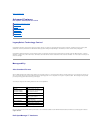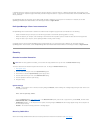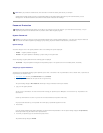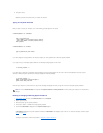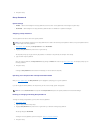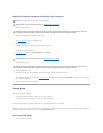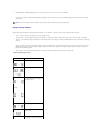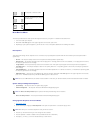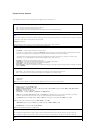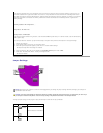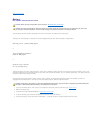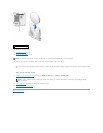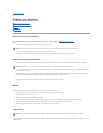
System Setup Options
To get additional information about any setup option, highlight the entry and press <F1>.
AC Power Recovery — determines what happens when AC power is restored to the computer.
l Off — Computer remains off when AC power is restored.
l On — Computer starts when AC power is restored.
l Last — Computer returns to the AC power state existing at the time that AC power was lost.
Asset Tag — displays the customer-programmable asset tag number for the computer if an asset tag number is assigned
Auto Power On — sets time and days of week to turn on the computer automatically. Choices are every day or every Monday through
Friday.
Time is kept in a 24-hour format (hours:minutes). Change the start up time by pressing the right- or left-arrow keys to increase or decrease
the numbers or type numbers in both the date and time fields.
Disabled is the default.
This feature does not work if you turn off your computer using a power strip or surge protector.
CPU ID — manufacturer's identification code for the installed microprocessor.
CPU Information
l CPU Speed — processor speed at which the computer boots.
Press the left- or right-arrow key to toggle the CPU Speed option between the resident microprocessor's rated speed (the default)
and a lower-compatibility speed. A change to this option takes effect immediately (no restart is necessary).
To toggle between the rated processor speed and the compatibility speed while the computer is running in real mode, press
<Ctrl><Alt><\>. (For keyboards that do not use American English, press <Ctrl><Alt><#>.)
l Bus Speed — speed of the microprocessor's system bus.
l Processor ID — manufacturer's identification code(s) for the installed microprocessor.
l Clock Speed — core speed at which the microprocessor(s) operates.
l Cache Size — size of the microprocessor's L2 cache.
l Hyper-Threading— enables or disables Hyper-Threading technology for operating systems that support Hyper-Threading. The default
setting is Disabled.
Fastboot
l On (default) — Your computer boots in 10 seconds or less, skipping certain configurations and tests.
l Off — Your computer does not skip certain configurations and tests during the boot process.
HDD Priority
l HDD (default)
l USB Device
NOTE: To boot from a USB memory device, select the USB device and move it to make it the first device.
Integrated Devices — configures the following devices integrated with the system board:
l Sound — settings are On (default) or Off
l USB Controller — settings are On or Off
l Network Interface Controller — settings are On (default), Off, or On w/ MBA. Settings for On w/ MBA are PXE, RPL, BootP, or
NetWare as the active boot mode
l Mouse Port — settings are On or Off
l Parallel Port — settings are Mode, I/O Address, and DMA Channel
Mode settings are PS/2, EPP, ECP, AT, or Off. Set the Mode option according to the type of device connected to the parallel
connector. To determine the correct mode to use, see the documentation that came with the device.
I/O Address settings are 378h (default), 278h, or 3BCh. The settings are not available when Mode is set to Off.
NOTE: You cannot set the parallel connector to 3BCh if Mode is set to EPP.
DMA Channel appears only when Mode is set to ECP. Settings are DMA 1, DMA 3, or Off.
l USB Emulation — settings are On, Off, and No Boot.
NOTE: No Boot disables booting from all USB devices.
Keyboard NumLock — settings are On and Off (does not apply to 84-key keyboards)
On — activates the rightmost bank of keys so they provide the mathematical and numeric functions shown at the top of each key.
Off — activates the rightmost bank of keys so they provide cursor-control functions shown by the label on the bottom of each key.
Memory Information — indicates amount of installed memory, computer memory speed, amount of video memory, and size of the display
cache.
If You Have a Problem



